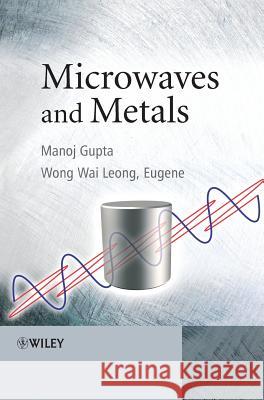Microwaves and Metals » książka



Microwaves and Metals
ISBN-13: 9780470822722 / Angielski / Twarda / 2007 / 256 str.
Microwaves and Metals
ISBN-13: 9780470822722 / Angielski / Twarda / 2007 / 256 str.
(netto: 749,86 VAT: 5%)
Najniższa cena z 30 dni: 785,18
ok. 16-18 dni roboczych
Dostawa w 2026 r.
Darmowa dostawa!
Introduces readers to the world of microwaves, placing emphasis on addressing fundamentals of its interactions with metals and metals-based formulations. This book includes overviews of microwave heating of other non-metal materials and the equipment used for microwave-assisted metallurgy.
"This comprehensive text introduces readers to microwaves and their interaction with metals." ( Materials World, October 2008)
Preface.
Acknowledgments.
1. Introduction to Microwaves.
1.1 Microwaves and Electromagnetic Radiation.
1.2 Development of Microwaves.
1.3 Applications of Microwaves.
1.3.1 Microwave Heating/Processing of Materials.
1.3.2 Communications.
1.3.3 Radio Detection and Ranging (Radar).
1.3.4 Electronic Warfare.
1.3.5 Medical Applications.
1.3.6 Scientific Applications.
1.3.7 Industrial and Commercial Applications.
1.3.8 Potential Applications.
1.4 Frequency Allocation.
1.5 Microwave Generators.
1.6 Summary.
References.
2. Microwaves – Theory.
2.1 Introduction.
2.2 Fundamentals.
2.2.1 Maxwell’s Equations.
2.2.2 Permittivity.
2.2.3 Permeability.
2.2.4 Power Dissipated.
2.2.5 Penetration Depth.
2.2.6 Rate of Increase in Temperature.
2.3 Microwave–Material Interactions.
2.3.1 Electronic Polarization.
2.3.2 Orientation or Dipolar Polarization.
2.3.3 Ionic or Atomic Polarization.
2.3.4 Interfacial (Maxwell–Wagner) Polarization.
2.3.5 Frequency Dependence of Polarization Mechanisms.
2.3.6 Conduction Losses.
2.3.7 Hysteresis Losses.
2.4 Summary.
References.
3. Microwave Heating.
3.1 Development of Microwave Heating.
3.2 Characteristics of Microwave Heating.
3.2.1 Penetrating Radiation.
3.2.2 Rapid Heating.
3.2.3 Controllable Field Distributions.
3.2.4 Selective Heating of Materials.
3.2.5 Self–limiting Characteristic.
3.2.6 Microwave Effects.
3.3 Types of Microwave Heating.
3.4 Future Developments.
3.5 Summary.
References.
4. Microwave Heating of Metal–Based Materials.
4.1 Microwaves and Metals.
4.2 Observations and Theories–Mechanisms Proposed for Microwave Heating of Metals.
4.2.1 Size and Morphology of Starting Materials.
4.2.2 Effect of Separate Electric and Magnetic Fields.
4.2.3 Sintering Behavior and Mechanisms.
4.2.4 Proposed Microwave Sintering Model by Luo et al.
4.2.5 Proposed Microwave Sintering Model by Rybakov et al.
4.2.6 Model for Microwave Heating of Metal Compacts.
4.3 Microwave Sintering of Metals.
4.3.1 Cermets.
4.3.2 Ferrous Alloys.
4.3.3 Copper Alloys.
4.3.4 Aluminum and Composites.
4.3.5 Magnesium and Composites.
4.3.5.1 Microwave Sintering of Magnesium Composites.
4.3.5.2 Effect of Microwave Heating Rate on Properties of Pure Magnesium.
4.3.6 Tungsten Alloys.
4.3.6.1 Effect of Particle Size Distribution and Phases on Densification.
4.3.6.2 Effect of Sintering Atmosphere on Densification.
4.3.6.3 Effect of Aspect Ratio of Samples on Densification.
4.3.6.4 Comparison of Sintering Methods on Densification.
4.3.6.5 Microwave Sintering of Nanocrystalline Tungsten Powders.
4.3.7 Tin–Based Alloys (Electronic Solders).
4.3.8 Hybrid Composites.
4.3.9 Layered Composites.
4.4 Other Applications for Microwave Processing of Metals.
4.4.1 Microwave Melting.
4.4.2 Microwave Steel–making.
4.4.3 Heat Treatment and Annealing.
4.4.4 Diffusion Coating.
4.4.4.1 Microwaves and Aluminization.
4.4.4.2 Microwaves and Chromization.
4.4.4.3 Microwaves and Boronization.
4.4.5 Surface Treatment.
4.4.6 Microwave Brazing and Bonding.
4.4.7 Microwave Plasma Processing of Metals.
4.4.8 Other Applications.
4.5 Summary.
References.
5. Microwave Heating of Other Materials.
5.1 Introduction.
5.2 Food Processing.
5.3 Ceramics Processing.
5.4 Polymer Processing.
5.5 Chemical and Pharmaceutical Processing.
5.6 Waste Remediation and Recycling.
5.7 Minerals Processing.
5.8 Biomedical Applications.
5.9 Other Applications.
5.10 Summary.
References.
Appendix A: Experimental Techniques in Microwave Processing.
A.1 Microwave Sintering of Cermets.
A.2 Microwave Sintering of Ferrous Alloys (1).
A.3 Microwave Sintering of Ferrous Alloys (2).
A.4 Microwave Sintering of Copper (1).
A.5 Microwave Sintering of Copper (2).
A.6 Microwave Sintering of Copper Alloys.
A.7 Microwave Sintering of Aluminum and Composites.
A.8 Microwave Sintering of Aluminum, Magnesium, Electronic Solders and Composites.
A.9 Microwave Sintering of Tungsten Alloys.
A.10 Microwave Heating in Separate E and H Fields.
Appendix B: List of Suppliers of Microwave Processing Equipment.
B.1 Types of Microwave Furnaces Available.
B.2 Manufacturers of Microwave Components and Thermal Insulation Materials.
B.3 Microwave Plasma Equipment.
B.4 Microwave Melting.
Appendix C: List of Research Groups in Metal–Based Microwave Processing.
C.1 Education and Research Institutes.
Index.
Manoj Gupta, Head – Materials Group, Department of Mechanical Engineering, National University of Singapore
Wong Wai Leong, Eugene, Department of Mechanical Engineering, National University of Singapore
Using microwaves to treat metal–based materials is rapidly emerging as an energy–efficient tool to interact with metals for a number of processes such as sintering, melting, brazing, carburizing and annealing. Microwaves can sinter a wide variety of metal compacts with comparable or enhanced end properties, while at the same time delivering tremendous energy savings over conventional sintering. Microwave processes are therefore gaining increasing attention and adoption in both academia and industry.
Gupta and Wong have written this comprehensive text to introduce readers to the world of microwaves and the interaction of microwaves with metals and metals–based formulations. The authors have combined numerous research results from a wide range of sources alongside their own work in the field. Also included are overviews of microwave heating of other non–metal materials and the equipment used for microwave–assisted metallurgy. With microwave techniques poised for widespread adoption, Microwaves and Metals is an essential text for all metallurgists and materials engineers.
- Provides a thorough grounding in microwave fundamentals and their application to metals processing
- Informs readers of the latest developments in the field
- Presents a convenient single source for all aspects of microwave processing of metals and materials
- Contains liberal illustration to compare and benchmark research results
- Introduces all the necessary equipment, preparing readers for real–world practice
Microwaves and Metals is ideal for a post–graduate or advanced undergraduate course in materials science or metallurgy. Materials and metallurgical engineers in industry, who are keen on cheaper, faster techniques, will also benefit from this book.
1997-2025 DolnySlask.com Agencja Internetowa
KrainaKsiazek.PL - Księgarnia Internetowa









